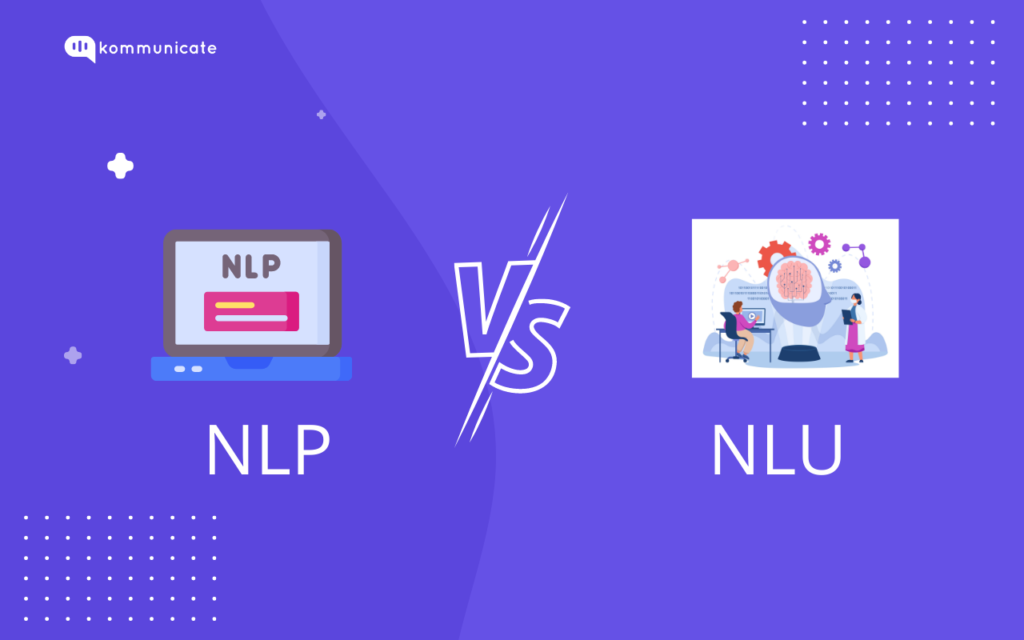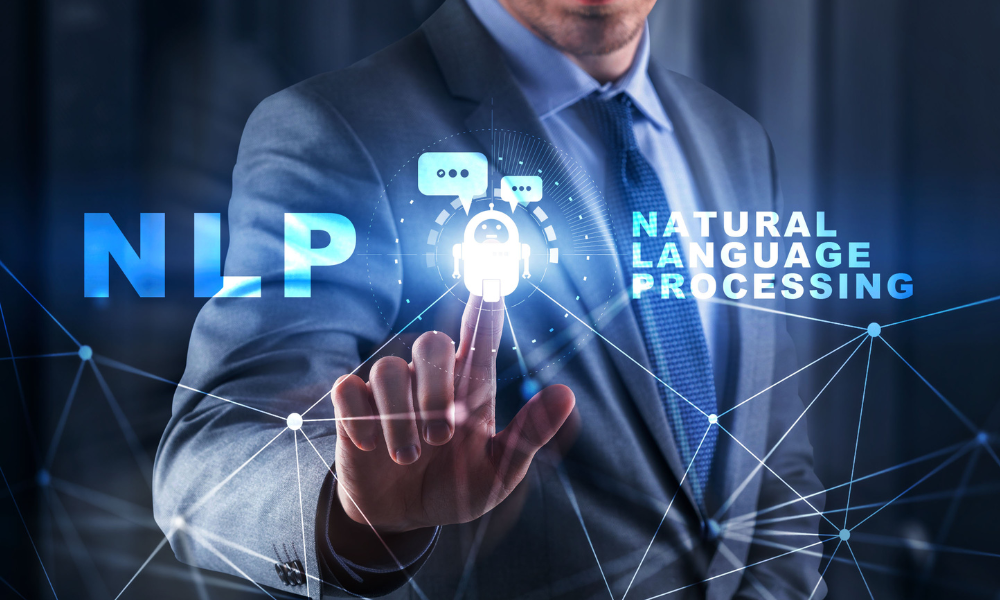Updated on January 15, 2025

Asking Alexa or Siri to order pizza is commonplace today. Almost every website features a pop-up chatbot window for users to ask questions, leave comments, or receive recommendations. But have you ever wondered what powers these interactions?
NLP, or Natural Language Processing, and NLU, Natural Language Understanding, are two key pillars of artificial intelligence (AI) that have truly transformed the way we interact with our customers today. These technologies enable smart systems to understand, process, and analyze spoken and written human language, facilitating responsive dialogue.
While often used interchangeably, NLP and NLU represent distinct aspects of language processing. This article delves into the difference between the two.
NLP Overview

Natural Language Processing focuses on the interaction between computers and human language. It involves the development of algorithms and techniques to enable computers to comprehend, analyze, and generate textual or speech input in a meaningful and useful way. The tech aims at bridging the gap between human interaction and computer understanding.
The key components covered by NLP embrace:
- Tokenization to break down the text into individual words or tokens, which is essential for further text analysis and comprehension;
- Part-of-speech tagging assigning grammatical tags (such as nouns, verbs, adjectives, etc.) to each word to analyze the syntactic structure of the text;
- Named entity recognition to identify and classify named entities, such as names of people, organizations, locations, and other specific terms within a text;
- Syntax and parsing analyzing the grammatical structure of sentences to determine the relationships between words and their syntactic roles to enable more detailed breakdown and comprehension of the sentence structure;
- Word embeddings render words as numerical indexes, grasping their semantic meaning and relationships to let computers figure out the contextual similarities and differences between words.
NLP already has numerous applications such as:
- Sentiment analysis involves detecting the sentiment or opinion expressed in a piece of text. This technique is employed in social media marketing and monitoring, customer feedback analysis, and brand reputation management.
- Automated translation uses various NLP techniques to analyze the framework and meaning of sentences in different languages.
- Text summarization techniques automatically generate concise summaries from long textual pieces for the users to quickly grasp the core concepts and key points of an article.
- Chatbots prioritized by companies in chatbot marketing rely on NLP to understand and respond to human speech. Processing techniques are applied to process and interpret user queries, enabling talk bots to produce relevant and accurate responses.
Technology continues to advance and contribute to various domains, enhancing human-computer interaction and enabling machines to comprehend and process language inputs more effectively.
NLU Overview
Natural Language Understanding provides machines with the capabilities to understand and interpret human language in a way that goes beyond surface-level processing. It is designed to extract meaning, intent, and context from text or speech, allowing machines to comprehend contextual and emotional touch and intelligently respond to human communication.
The core techniques and components of NLU include the following:
- Semantic breakdown extracting the meaning and intent behind a piece of text or speech to go beyond the literal sense of words and consider the underlying concepts and relationships between them;
- Intent recognition identifying the purpose or intention behind a user’s input to analyze user queries or statements for determining the desired action or goal, enabling systems to provide appropriate responses;
- Entity extraction discerning and extracting specific entities or named references from text or speech to discern names of individuals, organizations, locations, and other relevant information that provide context and comprehension;
- Contextual understanding to comprehend the context in which a piece of text or speech is used. NLU techniques consider the surrounding information, previous user interactions, and knowledge of the domain to interpret the meaning accurately.
NLU enables machines to grasp the deeper sense and aim behind text or speech, facilitating more authentic and resultative interactions between people and computers. The most prominent uses of technology are in
- Virtual assistants like Siri, Alexa, or Google Assistant utilize NLU algorithms to understand user commands, queries, or instructions and provide relevant answers or perform requested tasks;
- Voice-controlled devices such as smart speakers or home automation systems embed NLU to handle and respond to spoken commands, providing a hands-free and intuitive user experience
- Question-answering systems like automated DMs for Instagram interpret user queries and provide precise and meaningful answers. NLU techniques help in understanding the user’s query, extracting key information, and retrieving the appropriate response from a knowledge base.
How NLP and NLU Stack Up
Though looking very similar and seemingly performing the same function, NLP and NLU serve different purposes within the field of human language processing and understanding. How do these technologies compare then? The key distinctions are observed in four areas and revealed at a closer look.
Focus and Scope
NLP primarily works on the syntactic and structural aspects of language to understand the grammatical structure of sentences and texts. With the surface-level inspection in focus, these tasks enable the machine to discern the basic framework and elements of language for further processing and structural analysis.
NLU, on the other hand, is more concerned with the higher-level understanding. It aims to highlight appropriate information, guess context, and take actionable insights from the given text or speech data. The tech builds upon the foundational elements of NLP but delves deeper into semantic and contextual language comprehension. Involving tasks like semantic role labeling, coreference resolution, entity linking, relation extraction, and sentiment analysis, NLU focuses on comprehending the meaning, relationships, and intentions conveyed by the language.
Goals and Objectives
As the name suggests, the initial goal of NLP is language processing and manipulation. It focuses on the interactions between computers and individuals, with the goal of enabling machines to understand, interpret, and generate natural language. Its main aim is to develop algorithms and techniques that empower machines to process and manipulate textual or spoken language in a useful way. As such, it deals with lower-level tasks such as tokenization and POS tagging.
NLU goes beyond the basic processing of language and is meant to comprehend and extract meaning from text or speech. The prime aim of the technology is to enable machines to understand and interpret human language in a manner similar to humans, i.e. to read between the lines, figure out the intent and contextual meanings of the words, and generate intelligent answers and situational reactions. As a result, NLU deals with more advanced tasks like semantic analysis, coreference resolution, and intent recognition.
Techniques and Approaches
NLP utilizes statistical models and rule-enabled systems to handle and juggle with language. It often relies on linguistic rules and patterns to analyze and generate text. Handcrafted rules are designed by experts and specify how certain language elements should be treated, such as grammar rules or syntactic structures. Statistical approaches are data-driven and can handle more complex patterns.
NLU heavily relies on deep learning and machine learning techniques. It uses neural networks and advanced algorithms to learn from large amounts of data, allowing systems to comprehend and interpret language more effectively. NLU often involves incorporating external knowledge sources, such as ontologies, knowledge graphs, or commonsense databases, to enhance understanding. The technology also utilizes semantic role labeling (SRL) to identify the roles and relationships of words or phrases in a sentence with respect to a specific predicate.
Levels of Understanding
With an eye on surface-level processing, NLP prioritizes tasks like sentence structure, word order, and basic syntactic analysis, but it does not delve into comprehension of deeper semantic layers of the text or speech.
By way of contrast, NLU targets deep semantic understanding and multi-faceted analysis to comprehend the meaning, aim, and textual environment. NLU techniques enable systems to grasp the nuances, references, and connections within the text or speech resolve ambiguities and incorporate external knowledge for a comprehensive understanding.
While both technologies are strongly interconnected, NLP rather focuses on processing and manipulating language and NLU aims at understanding and deriving the meaning using advanced techniques and detailed semantic breakdown. The distinction between these two areas is important for designing efficient automated solutions and achieving more accurate and intelligent systems.
How NLP and NLU Relate
Despite distinct differences, these technologies represent two sides of the same process inherent in multiple AI solutions such as conversational agents and virtual assistants, extremely popular among e-commerce sites, cryptocurrency platforms like Coindataflow, healthcare organizations, travel businesses, etc.
When it comes to relations between these techs, NLU is perceived as an extension of NLP that provides the foundational techniques and methodologies for language processing. NLU builds upon these foundations and performs deep analysis to understand the meaning and intent behind the language.
NLU relies on NLP’s syntactic analysis to detect and extract the structure and context of the language, which is then used to derive meaning and understand intent. Processing techniques serve as the groundwork upon which understanding techniques are developed and applied.
In practical applications such as customer support, recommendation systems, or retail technology services, it’s crucial to seamlessly integrate these technologies for more accurate and context-aware responses.
Furthermore, the synergy between NLP and NLU enables feedback loops and iterative improvement in language understanding systems and fosters continuous innovation and progress in natural language technologies.
Both technologies are widely used across different industries and continue expanding. Already applied in healthcare, education, marketing, advertising, software development, and finance, they actively permeate the human resources field. For example, for HR specialists seeking to hire Node.js developers, the tech can help optimize the search process to narrow down the choice to candidates with appropriate skills and programming language knowledge.
Final Thought
In conclusion, the evolution of NLP and NLU signifies a major milestone in AI advancement, presenting unparalleled opportunities for human-machine interaction. However, grasping the distinctions between the two is crucial for crafting effective language processing and understanding systems. As we broaden our understanding of these language models, we edge closer to a future where human and machine interactions will be seamless and enriching, providing immense value to businesses and end users alike.

As a seasoned technologist, Adarsh brings over 14+ years of experience in software development, artificial intelligence, and machine learning to his role. His expertise in building scalable and robust tech solutions has been instrumental in the company’s growth and success.
At Kommunicate, we envision a world-beating customer support solution to empower the new era of customer support. We would love to have you on board to have a first-hand experience of Kommunicate. You can signup here and start delighting your customers right away.



![What is Conversational Intelligence [Benefits + Features] cover image of conversational intelligence.](https://www.kommunicate.io/blog/wp-content/uploads/2025/04/Featured-Images-1-1-1.avif)

